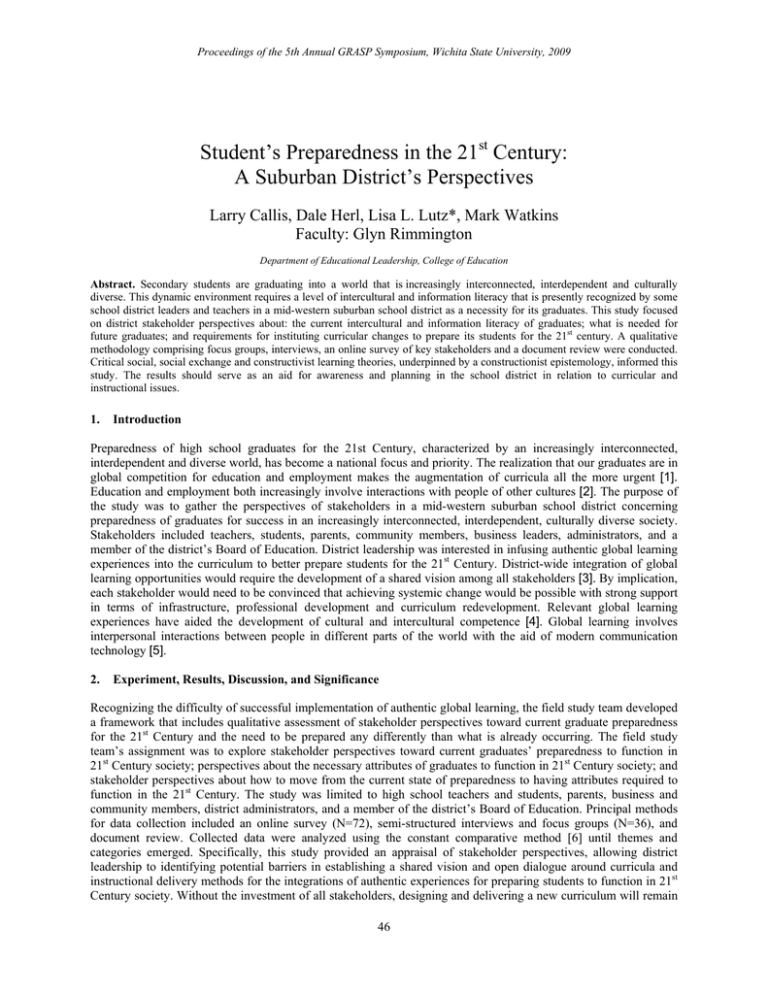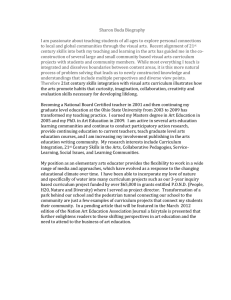Student’s Preparedness in the 21 Century: A Suburban District’s Perspectives
advertisement

Proceedings of the 5th Annual GRASP Symposium, Wichita State University, 2009 Student’s Preparedness in the 21st Century: A Suburban District’s Perspectives Larry Callis, Dale Herl, Lisa L. Lutz*, Mark Watkins Faculty: Glyn Rimmington Department of Educational Leadership, College of Education Abstract. Secondary students are graduating into a world that is increasingly interconnected, interdependent and culturally diverse. This dynamic environment requires a level of intercultural and information literacy that is presently recognized by some school district leaders and teachers in a mid-western suburban school district as a necessity for its graduates. This study focused on district stakeholder perspectives about: the current intercultural and information literacy of graduates; what is needed for future graduates; and requirements for instituting curricular changes to prepare its students for the 21st century. A qualitative methodology comprising focus groups, interviews, an online survey of key stakeholders and a document review were conducted. Critical social, social exchange and constructivist learning theories, underpinned by a constructionist epistemology, informed this study. The results should serve as an aid for awareness and planning in the school district in relation to curricular and instructional issues. 1. Introduction Preparedness of high school graduates for the 21st Century, characterized by an increasingly interconnected, interdependent and diverse world, has become a national focus and priority. The realization that our graduates are in global competition for education and employment makes the augmentation of curricula all the more urgent [1]. Education and employment both increasingly involve interactions with people of other cultures [2]. The purpose of the study was to gather the perspectives of stakeholders in a mid-western suburban school district concerning preparedness of graduates for success in an increasingly interconnected, interdependent, culturally diverse society. Stakeholders included teachers, students, parents, community members, business leaders, administrators, and a member of the district’s Board of Education. District leadership was interested in infusing authentic global learning experiences into the curriculum to better prepare students for the 21st Century. District-wide integration of global learning opportunities would require the development of a shared vision among all stakeholders [3]. By implication, each stakeholder would need to be convinced that achieving systemic change would be possible with strong support in terms of infrastructure, professional development and curriculum redevelopment. Relevant global learning experiences have aided the development of cultural and intercultural competence [4]. Global learning involves interpersonal interactions between people in different parts of the world with the aid of modern communication technology [5]. 2. Experiment, Results, Discussion, and Significance Recognizing the difficulty of successful implementation of authentic global learning, the field study team developed a framework that includes qualitative assessment of stakeholder perspectives toward current graduate preparedness for the 21st Century and the need to be prepared any differently than what is already occurring. The field study team’s assignment was to explore stakeholder perspectives toward current graduates’ preparedness to function in 21st Century society; perspectives about the necessary attributes of graduates to function in 21st Century society; and stakeholder perspectives about how to move from the current state of preparedness to having attributes required to function in the 21st Century. The study was limited to high school teachers and students, parents, business and community members, district administrators, and a member of the district’s Board of Education. Principal methods for data collection included an online survey (N=72), semi-structured interviews and focus groups (N=36), and document review. Collected data were analyzed using the constant comparative method [6] until themes and categories emerged. Specifically, this study provided an appraisal of stakeholder perspectives, allowing district leadership to identifying potential barriers in establishing a shared vision and open dialogue around curricula and instructional delivery methods for the integrations of authentic experiences for preparing students to function in 21st Century society. Without the investment of all stakeholders, designing and delivering a new curriculum will remain 46 Proceedings of the 5th Annual GRASP Symposium, Wichita State University, 2009 a challenge. Whether in suburban, rural or urban settings, the very consciousness of global interconnectedness, interdependence and cultural diversity will determine educational system structures, mindsets and practices worldwide [7]. There is evidence of differences in perspectives among stakeholder groups. Knowing these perspectives will aid the district in upcoming planning and decisions for professional development and curricula. 3. Conclusions Research indicated, to move forward, dialogue among stakeholders is essential. For instance, dialogue will be needed to construct a shared vision and to devise strategies, plans and processes to prepare 21st Century graduates. Voloshinov has stated, “…any true understanding is dialogic in nature. Understanding is to utterance what one line of dialogue is to the next…” [8]. Consideration for such dialogue could be given to existing collaborative structures and how they might be used to nurture local and global communication. Existing global synergies could provide models for sharing the district’s vision of what an education for preparing students to function in an interconnected, interdependent, and culturally diverse society. These synergies may include broadening language learning through immersion at an early age. This awareness can lead to new instructional practices that support the cultivation of adaptive intercultural competence [9]. Furthermore, these instructional practices may improve awareness of global interdependence and cultural differences in the education system. [1] Partnership for 21st Century Skills (2007). Beyond the three Rs: Voter attitudes toward 21st century skills. [2] Rader, H. (Ed.). (2003). Information literacy: A global perspective. London: Facet Publishing. [3] Senge, P. M. (1990). The fifth discipline: The art and practice of the learning organization (first ed.). Australia: Random House. [4] Rimmington, G. M., & Bever-Goodvin, S. (2005, March). Global learning for developing intra- and inter-personal intelligences. Paper presented at the Proc. 16th International Conf of Soc. for IT in Teacher Education, Phoenix, AZ. [5] Rimmington, G. M. (2003). An introduction to global learning. Proc. SITE 2003 14th International Conference of the Society for Information Technology & Teacher Education., Albuquerque, NM March 24-29 pp. 1536-1539. [6] Lincoln, Y.S., & Guba, E.G. (1985) Naturalistic Inquiry, Newbury Park, CA: Sage. [7] R. Bates, Can we live together? Towards a global curriculum, Vol. 4 Arts and Humanities in Higher Education, 2005. [8] Voloshinov, V. N. (1973). Marxism and the philosophy of language (L. Matejka & I. R. Titunik, Trans.). New York: Seminar Press. [9] E. W. Taylor, Intercultural competency: A transformative learning process, Vol. 44 Adult Education Quarterly, 1994. 47
